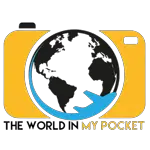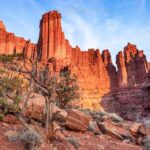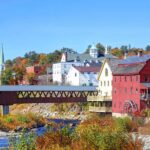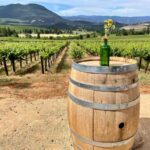If you’re trying to plan the very best time to go to Zion National Park, you’re in the right place. The bottom line? The best time to explore Zion National Park is during the fall, especially in late September, October, or early November. During this time, the park has fewer visitors, and since winter weather hasn’t arrived, you’ll still be able to do the majority of the hikes in the park.
However, depending on your personal preferences and what is most important to you, you might decide that spring, summer, or winter is a better bet. Each season has its pros and cons.
The summer months are a great option if you prefer warmer temperatures and want full access to all the trails and Kolob Canyon. Just make sure to start your day early, though, because this is peak tourist season, and there will be crowds.
Spring has fantastic weather and fewer crowds (except during spring break). However, the Narrows are often closed due to high river levels.
Winter can also be a great time to visit Zion National Park if you don’t mind bringing extra gear like microspikes and poles. During the winter, you’ll also have the best chance to land a permit for hiking Angel’s Landing.
The Best Time To Visit Zion National Park
Zion National Park in Spring

Spring in Zion is one of the best times to visit because there are fewer crowds and fantastic weather, but some areas of the park may be closed.
Late April or early May is our favorite time of year to do the Emerald Pools trail because the waterfall is at its fullest. We also love hiking Angel’s Landing in the Spring as permits are easier to get, and the weather is cooler.
The one downside of a visit during the spring months is that the Narrows hike is often closed. The river level is highest during these months due to melting snow runoff.

In a nutshell, if you’re planning a trip for the spring months of March through early May, here’s what you’ll want to keep in mind:
- Narrows Closure: The Narrows are often closed due to high water levels.
- South Campground: This campground opens during spring but may not be open in early March.
- Spring Break: Most Utah schools are out for spring break at the end of March or the beginning of April, and Zion sees a huge spike in visitors during these weeks.
- Emerald Pool Trails: The waterfalls on the Emerald Pool trail are full and beautiful during the spring months. However, the park will close the trail if there’s too much water or overflow.
- Temperatures: The temperature can be moderate in the afternoons but still very chilly in the morning and evening; you’ll definitely want to dress in layers.
- Kolob Canyon and Kolob Terrace Road: These areas are usually open in late May or June.
- Shuttle Schedule: The shuttle service typically begins operating during this season. Check the NPS website for the updated shuttle schedule.
Visiting Zion National Park in the Summer

Summer is the best time to visit if you want the best chance of full access to every trail in the park or prefer warm weather. However, this is also peak tourist season, so you’ll be sharing the trail with lots of visitors.
Summertime has the advantage of longer daylight hours, so it can be a great time to visit if you’re hoping to do a long through-hike, such as the top-down West Rim trail.
Here are the most important things to remember if planning a trip during the summer:
- Hiking the Narrows: Warmer temperatures during the summer make hiking the Narrows much more comfortable, and you may not need to rent a drysuit. However, flash floods are more common between July and September. Be sure to check current conditions before heading out.
- Hot Weather: Temperatures can get over 100°F during the summer months. Especially for hard hikes like Angel’s Landing, you’ll want to start early to beat the heat. You should also carry at least two liters of water; most shuttle stops have refill stations.
- Parking: The Visitor Center parking lot tends to fill up quickly, typically by 8 or 9 a.m. If you arrive later, you’ll likely need to park in the nearby town of Springdale and then take the Springdale shuttle to the Zion Visitor Center.
- Permits: All hikers need a valid permit to hike Angel’s Landing past Scout’s Lookout point. Getting a permit can be more challenging during summer due to the higher number of tourists.
- Crowds: Expect the biggest crowds on Memorial Day, the 4th of July, and Labor Day. Late May and September generally have fewer visitors, so these months are a great option if you’re trying to take advantage of the warmer weather and avoid the worst of the crowds.
Visiting Zion National Park in Autumn

Fall is hands-down our favorite time to visit Zion. Even though the days are shorter, the weather is still comfortable, and far fewer people are in the park.
Zion actually has its fair share of gorgeous fall colors. The West Rim trail from Scout’s Lookout up to the overlook Plateau with the campsites is our absolute favorite trail to do in the fall.
If you’re planning a fall visit, here’s what you’ll want to remember:
- Wear Layers: Like in springtime, the temperatures in Zion can vary a lot. The afternoons can still get warm, while the mornings and evenings are chilly. Make sure to bring a jacket and long pants that can either be rolled up or zipped off into shorts.
- Shorter Days: Fall days are shorter, so check sunrise and sunset times, especially if you’re planning long hikes like the Narrows top-down or the full top-down West Rim Trail.
- Human History Museum Closure: The Human History Museum closes at the end of November, so if you’re interested in visiting it, be sure to visit before then.
- Shorter Shuttle Service Hours: Starting on September 16th, the last shuttle runs at 7:15 instead of 8:15 (during the summer months). And, starting on November 3rd, the last shuttle runs at 6:15 pm.
- Kolob Closure: The Kolob Canyons road closes when snowfall begins, usually in November.
Zion in the Winter

If avoiding the crowds is your top priority, winter is a fantastic time to visit Zion. As long as you don’t mind the colder temperatures, many of Zion’s trails are still very doable in the winter.
The Observation Point lookout via the East Mesa Trail is one of our favorites for wintertime. The hike isn’t very steep, and if you can catch a day with recent snowfall, the white snow against the red rock is stunning.
We’ve even hiked Angel’s Landing in the winter, although you definitely need microspikes and it’s still a little dicey.
In summary, here’s what you’ll want to know for a winter visit to Zion:
- No Shuttle Service: Unlike in other seasons, no shuttle service is available in winter. Visitors can drive through the park instead. This can be a pro or a con, depending on your preferences.
- Extra Gear: While Zion sees plenty of days with no snow, some of the trails, especially those with higher elevations, will often have icy patches. We recommend packing hiking spikes and trekking poles if you plan to hike in Zion during the winter.
- Easier to Get Permits: Getting permits for Angel’s Landing is easier during the winter. However, you’ll also want to be very careful on more dangerous trails like this one. While it’s still doable in the winter, any icy patches can make it much more dangerous.
- Kolob Terrace Road Closure: While the southern and eastern entrances remain open throughout the year, the Kolob Canyon entrance and Kolob Terrace Road are closed during winter.
- Hiking the Narrows: While you can still hike the Narrows during the winter, you will absolutely need a drysuit, and the shorter days make completing this hike much more difficult.
Average Sunrise and Sunset Times in Zion National Park by Month

Double-checking the sunrise and sunset times is an important part of planning your trip to Zion. Especially if you are doing a long through hike like the Narrows Top-down route or the full West Rim Trail, you’ll want to make sure that you’re not going to get caught hiking in the dark.
Here’s a quick summary of Zion’s sunrise and sunset times during different months of the year from timeanddate.com.
| Sunrise First of the Month | Sunset First of the Month | Day Length First of the Month | |
| January | 7:46 AM | 5:25 PM | 9 hr 38 min |
| February | 7:35 AM | 5:56 PM | 10 hr 20 min |
| March | 7:02 AM | 6:26 PM | 11 hr 24 min |
| April | 7:16 AM | 7:55 PM | 12 hr 38 min |
| May | 6:36 AM | 8:22 PM | 13 hr 45 min |
| June | 6:12 AM | 8:47 PM | 14 hr 34 min |
| July | 6:15 AM | 8:56 PM | 14 hr 40 min |
| August | 6:37 AM | 8:39 PM | 14 hr 1 min |
| September | 7:03 AM | 7:59 PM | 12 hr 56 min |
| October | 7:28 AM | 7:14 PM | 11 hr 46 min |
| November | 7:57 AM | 6:33 PM | 10 hr 36 min |
| December | 7:28 AM | 5:14 PM | 9 hr 46 min |
Tips for Visiting Zion National Park During Any Time of the Year

Regardless of when you decide to visit the park, there are some things you’ll want to do to make things go more smoothly.
Our biggest recommendation is to start early. During the shuttle season, try to be on the very first shuttle of the day. During the summer months, the line for the shuttle can get long, so you’ll want to arrive at least 30 minutes before departure time to make sure you get a seat.
Other Tips We Recommend
- Make Reservations in Advance: This applies to camping, lodging, and hiking permits. For Angel’s Landing, you can enter an advance lottery four months before the trip. We recommend this if you really want to guarantee a permit.
- Bring Plenty of Water: We recommend bringing two 1-liter bottles and refilling them every chance you get. There are water refill stations at most of the shuttle stops in Zion Canyon.
- Pack Your Own Food: Packing a lunch and plenty of hiking snacks will save you the hassle of having to take the shuttle back to the Red Rock Grill for lunch.
- Always Check the Weather: Don’t just check the weather when planning your trip. Once you’re in the park, always check the weather the night before or the morning of your hikes. Especially for hikes like the Narrows, you always want to make sure you know about any potential flash floods.
- Don’t Feed the Chipmunks: This has previously been a big problem, especially at the top of Angel’s Landing, and the park has the right to fine anyone caught doing it. Be respectful of the wildlife!
- Remember your Park Pass: You’ll need either a day pass, a Zion Annual Pass, or the America the Beautiful Pass in order to enter the park. And you’ll need to have your pass with you if you decide to leave the park and then re-enter (even if on foot).
The Best Time to Go to Zion National Park: In Summary

We love that Zion is so visitable during every season of the year. While we prefer the shoulder seasons of spring and fall, summer and winter have their own upsides. Here’s a summary of what we like best about each season in Zion:
Spring is best for the Emerald Pools Trail and one of the best seasons for hiking Angel’s Landing. The Narrows hike is often closed.
Summer is best for longer days, a longer shuttle service, and access to every trail, campground, and museum in the park.
Fall is the best season overall due to fewer crowds and great weather. This is also the best season for hiking the Narrows, as the water levels are low.
Winter is best for getting away from the crowds and seeing white snow against red rock. You’ll need to bring extra gear, and certain hikes, like Angel’s Landing, are often dangerous.
Zion National Park is an absolute gem that you can enjoy anytime, no matter the season. Whether you’re looking for a fall hike through the Narrows or want to escape the crowds during the winter, everyone can find the perfect time for them that suits exactly what they’re looking for.
No matter which season you choose, you’ll have a fantastic experience if you plan ahead, pack appropriately, and follow the rules.
For more articles about the United States, check out my recommendations below:
- How to hire a car in the States
- Best cities to visit in New Hampshire
- What food is California known for?
Like it? Pin it!

Disclaimer: Some of the links on this website are “affiliate links.” This means that if you click on the link and do a purchase, I will receive an affiliate commission at no extra cost for you. This helps me keep my website running and continue to share my travelling knowledge with you. I thank you for booking your flights or hotels using the links on my website. Regardless, I only recommend products or services I use personally and believe will add value to my readers.





I absolutely loved Zion National Park and leveraged my “America the Beautiful” annual pass. I feel like more people need to purchase this pass! You provided great tips!